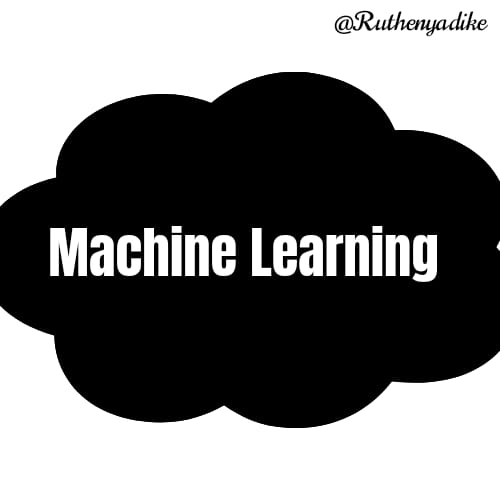Understanding Machine Learning
 Ruth Enyadike
Ruth Enyadike
Introduction: Machine Learning is a phenomenal field that continues to Structure the world. You have the opportunity to explore this exciting guild and unleash your creativity, get ready to embark on this thrilling journey!, here you'll learn about algorithms, experiments with data which will help unlock your potential of machine learning.
Table Of Contents✨
What machine learning is?
Key concepts of machine learning.
Types of machine learning.
Validating and Overfitting.
Applications of machine learning.
Online Resources For Machine Learning.
Note: Understand the foundational concepts of mathematics and programming before diving into machine learning.
Machine Learning is a variety of artificial intelligence that enables computers and systems to learn predictions or decisions without being explicitly programmed. Instead of following specific instructions, machines analyze large amounts of data, identify patterns, and use them to make predictions or take actions.
Computers learn from a process known as training. Let's say you want to train a computer to recognize different recipes of food, during the process of training, you have to start by showing it pictures of yam and beans, or many more recipes. your computer will use patterns to create mathematical models or algorithms to analyze these pictures and look for patterns and what differentiates the pictures of the Food. Now if you add a new picture of food to your computer, it predicts according to the pictures it learnt before, applying a model to these new pictures. If it makes mistakes you provide feedback to help improve its predictions and adjust its model.
Here are the Key concepts of machine learning includes the following:
Data: Data is the information that a computer uses to learn and make predictions, or collect clues that detect valuable information. You can also think of data as the foundation of machine learning, without data machine learning would be like a detective without clues.
Algorithms: Algorithms are a mathematical model or recipe that processes data which tells the computer what to do when data is inputted. It provides a roadmap for computers to navigate and understand complex tasks. They're considered to be the backbone of machine learning.
Training: We call this teaching! Training is the process of teaching a computer to learn from data and make accurate predictions or decisions. It is also a fundamental aspect of machine learning to acquire knowledge from data and improve performance.
Testing and Evaluation: These are explicit steps in the machine learning process for stimulating real- world scenarios and assess how well the computer generalizes what it learned, patterns to new or unseen data. Evaluation helps determine the strength and weakness of the model, allowing further refinement or adjustments if necessary.
Types of Machine Learning
Machine Learning comprises different approaches and techniques to help computers learn about data and predictions or decisions. Here are the main types of machine learning listed below:
Supervised Learning: This is when you have a knowledge mentor who guides you through any learning process. In this approach, the algorithm learns from the labeled dataset where the input data and the corresponding output labels are provided. This is commonly used for tasks like classification.
Unsupervised Learning: TqQqhis is basically the opposite of what supervised Learning is. Exploring a new territory without any guidance, the algorithm's object is to discover patterns, structures, or relationships within the data.
Reinforcement Learning: Imagining a Robot that behaves just like you, that reinforcement learning, it mimics the way humans learn by taking actions and receiving rewards or penalties based on its behavior. This learning is commonly used in areas such as robotics, game playing, or autonomous systems. Each of this machine learning has its own characteristics and applications, allowing programmers to deal with a wide range of problems.
Validating and Overfitting: Validating the model's performance are key steps to building reliable and effective machine learning solutions, to gain insight into how well the model generalizes its learned patterns to new, unseen data. Overfitting occurs when a machine learning model becomes overly complex and starts to memorize the training data instead of learning the underlying patterns. This happens when the model becomes too specialized in capturing noise or peculiarities of training data, resulting in poor generalization to new, unseen data. Validating can help prevent Overfitting by providing an unbiased assessment of a machine learning model's performance on unseen data. This provides more evaluation of models performance and helps detect Overfitting patterns that may occur in specific subset of data. In early detection of Overfitting, it helps enable hyperparameter tuning, facilitates regularization selection, and allows for cross- validation to improve the robustness of evaluation.
Applications of Machine Learning
Just like humans learn from experience, machine learning algorithms analyze massive amounts of information and identify patterns to make predictions or decisions. It's like having a digital brain that can process and understand complex data. Here are some areas where machine learning is applied:
Personalized Recommendations: Ever wondered how streaming platforms recommend movies or songs tailored just for you? Machine learning algorithms analyze your preferences, behavior, and similar users' data to suggest content you'll likely enjoy. It's like having a personal DJ or a virtual movie critic.
Age And Speech Recognition: Machine learning powers impressive applications like facial recognition or voice assistants. From unlocking your phone with your face to dictating commands to virtual assistants like Siri or Alexa, machine learning algorithms help computers understand and interact with us more naturally.
Fraud Detection: Banks and financial institutions utilize machine learning to detect fraudulent transactions. By analyzing patterns and historical data, algorithms can identify suspicious activities, such as unusual spending patterns or fraudulent credit card usage, helping to protect customers and their finances.
Medical Diagnosis: Machine learning plays a significant role in healthcare. Algorithms are trained on vast amounts of medical data to aid in disease diagnosis, early detection, and treatment planning. They can identify patterns in medical images, predict potential health risks, and even assist in drug development.
Autonomous Vehicles: Self-driving cars are revolutionizing the automotive industry. Machine learning algorithms process real-time data from sensors, cameras, and GPS to analyze the road conditions, detect objects, and make driving decisions. This technology aims to enhance road safety and transform transportation as we know it.
Conclusion
I'm glad You've taken your first steps into the world of machine learning. Remember, machine learning is an exciting field with vast possibilities. Keep exploring and learning, and you'll unlock incredible opportunities!.❣️
There are numerous online courses available for learning machine learning. Here are some popular and highly recommended options:
"Practical Deep Learning for Coders" by fast.ai
Provider: fast.ai (edX)
CourseLink: https://www.edx.org/professional-certificate/deep-learning-for-codersacity
Course: "Machine Learning Engineer Nanodegree"
Provider: Udacity
CourseLink: https://www.udacity.com/course/machine-learning-engineer-nanodegree--nd009ggle
Courses: "Intro to Machine Learning" and "Intermediate Machine Learning"
Provider: Kaggle
CourseLink: https://www.kaggle.com/learn/intro-to-machine-learningtaCamp
Course: "Machine Learning with Python"
Provider: DataCamp
CourseLink: https://www.datacamp.com/courses/machine-learning-with-python
These courses provide a solid foundation in machine learning and cater to learners with different levels of expertise. Remember to check the prerequisites, syllabus, and learner reviews to find the course that best suits your needs and learning style. HAPPY Learning!🌝
References: wikipedia.org, google.com.ng.
Subscribe to my newsletter
Read articles from Ruth Enyadike directly inside your inbox. Subscribe to the newsletter, and don't miss out.
Written by

Ruth Enyadike
Ruth Enyadike
Ruth's commitment to delivering clear, accurate, and user-centric documentation sets Her apart as a skilled and reliable technical writer, create engaging and informative content for various audiences.